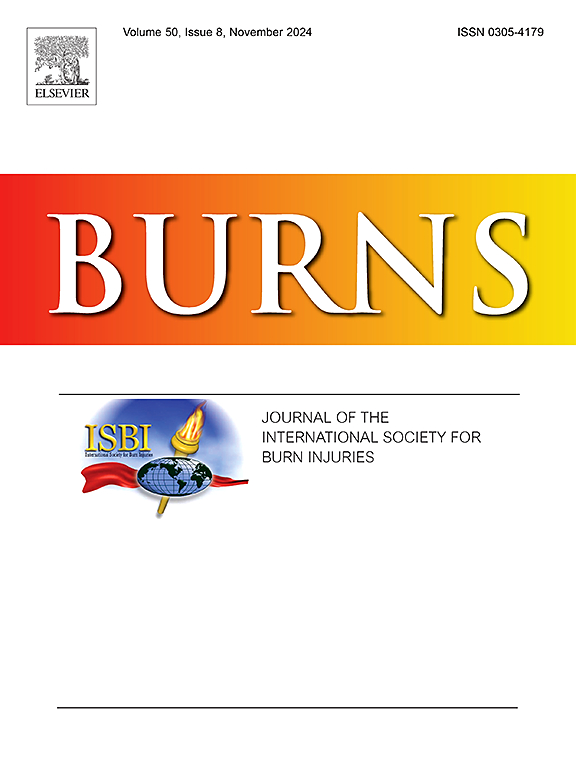Paediatric steam burns in New South Wales, Australia: A 14-year retrospective study
IF 2.9
3区 医学
Q2 CRITICAL CARE MEDICINE
引用次数: 0
Abstract
Background
Burns from steam are often small but may cause significant harm. To further investigate this, a 14-year retrospective review was conducted of paediatric patients presenting for the treatment of a steam burn injury at The Children’s Hospital at Westmead (CHW), New South Wales (NSW), Australia between 2010 and 2024.
Methods
Data from the NSW Statewide Burns Injury Service and patient medical records were collected and analysed. This included information on patient demographics, burn injury, and treatment.
Results
A total of 159 patients were identified with steam burns. Steam burns were sustained from a variety of devices and appliances including steam vapourisers and other kitchen and household appliances. A significant increase (266 %) in steam burns was observed during 2022-4 over the previous years, with steam vapourisers accounting for 84 % of cases, coinciding with the peak of the COVID-19 outbreak in NSW. Males were more commonly affected (59.7 %), with hands being the most frequently burned area (78.6 %). Among the patients, 81.1 % were infants aged 0–1 year, 31 required grafting, and 20 developed hypertrophic scars requiring long-term care.
Conclusion
While most steam burns in children involved a small percentage of the total body surface area, they could still result in deep injuries with potential long-term functional impairment caused by the development of problematic scarring, particularly with burns affecting the hands. These findings highlight the need for increased awareness, prevention messaging, and promotion of prevention strategies to minimise harm and promote safer use of household appliances, particularly in homes with young children.
澳大利亚新南威尔士州儿童蒸汽烧伤:一项为期14年的回顾性研究
蒸汽烧伤通常很小,但可能造成重大伤害。为了进一步研究这一点,对2010年至2024年间在澳大利亚新南威尔士州韦斯特米德儿童医院(CHW)治疗蒸汽烧伤的儿童患者进行了14年的回顾性研究。方法收集新南威尔士州烧伤服务中心的数据和患者医疗记录进行分析。这包括患者的人口统计资料、烧伤情况和治疗情况。结果159例患者被确诊为蒸汽烧伤。蒸汽烧伤是由各种装置和电器造成的,包括蒸汽汽化器和其他厨房和家用电器。与前几年相比,2022-4年期间观察到蒸汽烧伤的显著增加(266 %),蒸汽汽化器占病例的84% %,与新南威尔士州COVID-19爆发的高峰期相吻合。男性更常见(59.7% %),手是最常见的烧伤部位(78.6% %)。在这些患者中,81.1 %为0-1岁的婴儿,31例需要移植,20例发生增生性疤痕需要长期护理。结论:虽然大多数儿童蒸汽烧伤只涉及体表面积的一小部分,但仍可能导致深度损伤,并可能因瘢痕形成而导致长期功能障碍,特别是手部烧伤。这些发现突出表明,需要提高认识,宣传预防信息,促进预防战略,以尽量减少危害,并促进更安全地使用家用电器,特别是在有幼儿的家庭中。
本文章由计算机程序翻译,如有差异,请以英文原文为准。
求助全文
约1分钟内获得全文
求助全文
来源期刊

Burns
医学-皮肤病学
CiteScore
4.50
自引率
18.50%
发文量
304
审稿时长
72 days
期刊介绍:
Burns aims to foster the exchange of information among all engaged in preventing and treating the effects of burns. The journal focuses on clinical, scientific and social aspects of these injuries and covers the prevention of the injury, the epidemiology of such injuries and all aspects of treatment including development of new techniques and technologies and verification of existing ones. Regular features include clinical and scientific papers, state of the art reviews and descriptions of burn-care in practice.
Topics covered by Burns include: the effects of smoke on man and animals, their tissues and cells; the responses to and treatment of patients and animals with chemical injuries to the skin; the biological and clinical effects of cold injuries; surgical techniques which are, or may be relevant to the treatment of burned patients during the acute or reconstructive phase following injury; well controlled laboratory studies of the effectiveness of anti-microbial agents on infection and new materials on scarring and healing; inflammatory responses to injury, effectiveness of related agents and other compounds used to modify the physiological and cellular responses to the injury; experimental studies of burns and the outcome of burn wound healing; regenerative medicine concerning the skin.
 求助内容:
求助内容: 应助结果提醒方式:
应助结果提醒方式:


